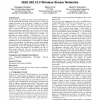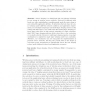28 search results - page 4 / 6 » WiseMAC: An Ultra Low Power MAC Protocol for Multi-hop Wirel... |
MSWIM
2009
ACM
14 years 3 months ago
2009
ACM
In recent years, the number of sensor network deployments for real-life applications has rapidly increased and it is expected to expand even more in the near future. Actually, for...
PIMRC
2008
IEEE
14 years 2 months ago
2008
IEEE
— The Internet of Things, emerging pervasive and sensor networks are low data-rate wireless networks with, a priori, no specific topology and no fixed infrastructure. Their pri...
MASS
2010
13 years 6 months ago
2010
Wireless sensor networks typically conserve energy by following a periodic wakeup-sleep schedule: nodes minimize idle time and spend most of their time in a low power sleep state. ...
EWSN
2007
Springer
14 years 8 months ago
2007
Springer
Abstract. This paper introduces Crankshaft, a MAC protocol specifically targeted at dense wireless sensor networks. Crankshaft employs node synchronisation and offset wake-up sched...
EWSN
2009
Springer
14 years 9 months ago
2009
Springer
Sensor sleeping is a widely-used and cost-effective technique to save energy in wireless sensor networks. Protocols at different stack levels can, either individually or simultaneo...


